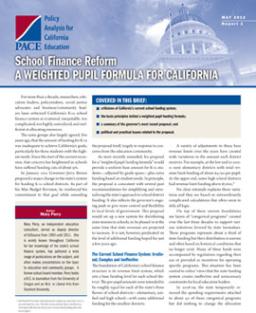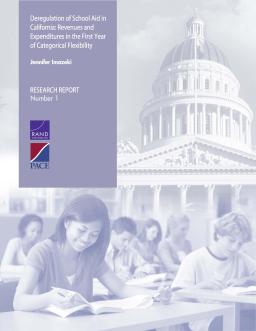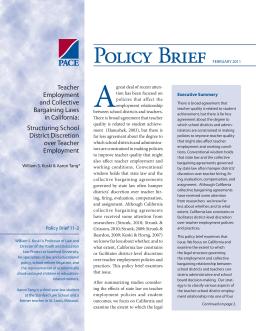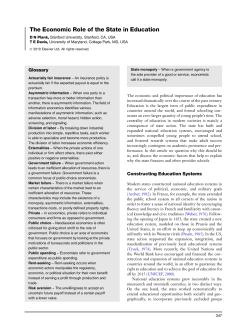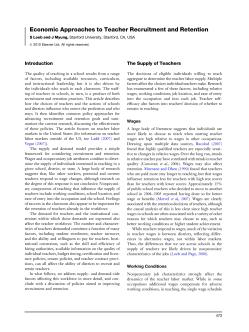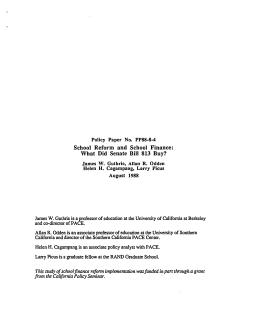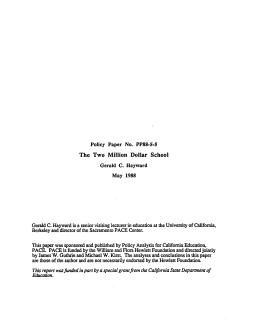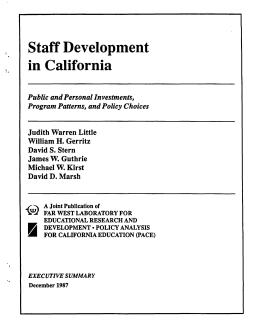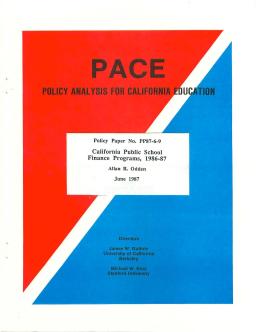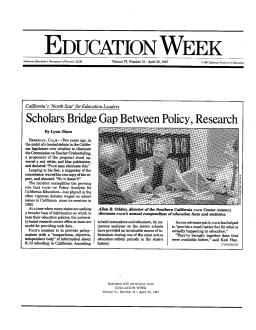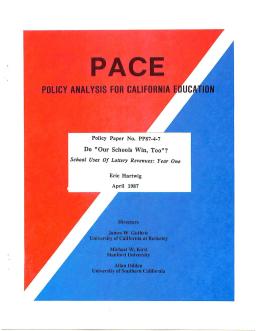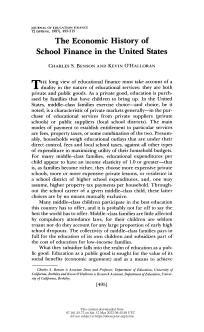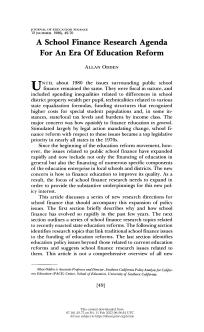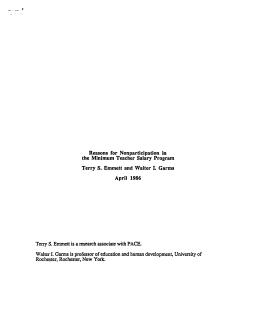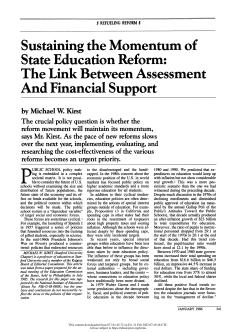A Weighted Pupil Formula for California
Published
Summary
Governor Jerry Brown has called for a major overhaul of California’s school finance policies. His proposal for a weighted pupil funding system would simplify the rules that govern the distribution of funds to schools and school districts, while targeting a larger share of available resources to the schools and students with the greatest needs. In this policy report Mary Perry offers an overview and analysis of the policy change that the Governor has proposed.
How 10 Districts Responded to Fiscal Flexibility, 2009–2010
Published
Summary
This report explores how 10 California school districts responded to the deregulation of $4.5 billion in education funding, which became entirely flexible in 2009. The study investigates how district leaders made budget decisions and what local factors influenced their responses. The research was conducted by a team of scholars from the RAND Corporation, UC Berkeley, UC Davis, and San Diego State University.
Revenues and Expenditure in the First Year of Categorical Flexibility
Published
Summary
This report discusses the effects of California's partial release of categorical funds to local school boards in 2009. The increased flexibility has provided an opportunity to observe how districts respond to the policy change, but the impact is difficult to isolate as most districts have been struggling to maintain core services during a severe budget crisis. The report includes preliminary results from an ongoing study of district responses to the increased categorical flexibility.
Structuring School District Discretion over Teacher Employment
Published
Summary
This brief analyzes the relationship between teacher employment, collective bargaining laws, and school district policies in California. The authors examine the extent to which California's legal structure constrains or facilitates district-level discretion over teacher employment policies and practices. They classify various aspects of the teacher-school district employment relationship into four categories, and conclude that California statutory law is somewhat more constraining of administrative decision-making in teacher employment matters than in four other large and diverse states.
California’s Quality Education Investment Act
Published
Summary
This working paper examines the use of Quality Education Investment Act (QEIA) funds, which allocated $2.6B over seven years to California's lowest-performing schools. The authors conducted a study of four Los Angeles high schools to investigate how QEIA dollars were spent in the first year, who made the decisions, and how funds were used to improve teaching and the instructional program. The study found that district officials and principals had discretion in allocating funds, consistent with recent efforts to deregulate categorical-aid programs and give local educators fiscal discretion.
Published
Summary
This article explores the reasons why education has become a central focus of modern societies and the largest public expenditure around the world. The state has built and expanded national education systems, made attending school mandatory, and linked adult success to academic performance. The article delves into the economic factors behind state financing and provision of schools.
Published
Summary
This article discusses how teacher recruitment and retention affect the quality of teaching in schools. The supply and demand model, including wages and non-pecuniary job attributes, influences the supply of potential and current teachers. The demand for teachers depends on factors such as student enrollment and institutional constraints such as hiring authorities' skill and efficiency. The article identifies common policy approaches to improve recruitment and retention and summarizes current research on their effectiveness.
Published
Summary
Economics of education has grown in importance over the past two decades, as education is viewed as a critical factor in a nation's economic success. Economics can help improve the productivity of educational institutions by focusing on incentives, choice, and competition. The article reviews important theoretical concepts in the economics of education, including human capital, markets, and education production, and how they have been used in empirical studies.
Published
Summary
California's growing child population will require significant increases in public spending, particularly in education due to immigration, working parents, poverty, and family disorganization. Counties and school districts bear the brunt of providing children's services, but cities have greater fiscal flexibility and revenue-raising potential. This paper provides information on county children's services and trends in county budgets to support further research on county financing for children's services.
1960 to 1988
Published
Summary
Public school funding in the US has seen continuous increases in real funding since 1960, reflecting strong citizen support for public schools and a growing economy. Despite pessimism and recession in the 1980s, real school funding continued to increase substantially. This report provides an overview of school revenues and funding increases needed for education reforms, and details changes in education finance during the 1980s, comparing increases to the levels needed to fund proposed reforms.
What Did Senate Bill 813 Buy?
Published
Summary
California's K-12 schools are supported by a vast amount of public money, and education financing has become an intensely political issue. This report analyzes school financing outcomes, including equity, efficiency, distributional consequences, and academic rigor, and addresses the conditions of school finance equality. The report seeks to provide answers to important questions about the amount of money being spent, how it compares to other states, who benefits from the funding, and whether added state funds have bought more rigorous schooling.
Published
Summary
In 1987, the Superintendent of Public Instruction released a document detailing the average costs of California schools for 1985-86, providing a brief summary of school expenditures. However, this report lacks in detail, and this report aims to provide more comprehensive and realistic data on school expenditure patterns. The report serves as an analytical base for exploring issues surrounding school expenditures in California, and the data was provided by the state Department of Education staff.
Public and Personal Investments, Program Patterns, and Policy Choices—Executive Summary
Published
Summary
The California Staff Development Policy Study was initiated to assess the possibilities and limitations of staff development in improving classroom teaching and learning. The study aims to answer four questions related to California's investment in staff development, how staff development activities are administered, and how teachers and administrators judge their effectiveness. The study yields eight main conclusions, presented in terms of investment and focusing on improving the capacities and commitments of California's educators.
Published
Summary
This report provides an overview of California's school finance system, including selected school finance facts; descriptions of the general revenue limit and categorical programs funding formulas; and, for each program, the amount appropriated for 1986-87, the number of districts participating, and number of students served.
Published
Summary
PACE, a university-based research center, provides "nonpartisan, objective, independent" information on K-12 schooling in CA. Its analyses have been invaluable to lawmakers and educators during the state's active education-reform period. PACE has played a growing role in debates on school issues, exemplified by a heated debate in the CA legislature over the Commission on Teacher Credentialing. PACE offers a model for providing data for education policies when many states are seeking broader information bases. It has helped provide a better understanding of what is happening in education.
School Uses of Lottery Revenue—Year One
Published
Summary
The report discusses the implementation and impact of California's State Lottery. During its first year of operation, the lottery generated $1.77 billion in ticket sales, with $689 million going towards public education. However, the article highlights the uncertainty surrounding the use of these funds and concerns about the reliability of the lottery as a source of education revenue. The study surveyed California K-12 public school districts regarding their use of lottery revenues and attitudes towards the program.
Published
Summary
This paper argues that the components of educational provisions which satisfy private demands, mythology aside, almost invariably win out over the public goods components. If true, this leads, on the one hand, to a diminished supply of social benefits, and, on the other, to a stifling of social mobility. Insofar as these arguments are correct, they also may apply in most countries of the world, whether capitalist or socialist.
1985–86 Evaluation Report
Published
Summary
Peninsula Academies are three-year high school programs designed for at-risk students, combining academic and technical training. Since 1981, they've been operating in California, and in 1985, ten new programs were created under state sponsorship. This report evaluates the quality of implementation and evidence of measurable impact on students after the first year. The report is based on site visits, questionnaire responses, and student data gathered from each high school. The Academy model is complex, but some sites didn't fully realize all components.
Published
Summary
Before the 1970s, public school finance issues were mainly related to spending inequalities. However, since then, the focus has shifted towards financing education to improve its quality. This article suggests new research directions for school finance that address this policy interest, including topics related to state education reforms, traditional school finance issues, and education policy issues beyond current reforms.
Published
Summary
California's K-12 education system has experienced funding instability, with revenues per pupil fluctuating and staying constant for years. The education system is attempting a major program of quality improvements while keeping funding constant, a challenge that may be difficult to maintain in the future. The state gives K-12 education a lower priority than most other states when state revenues are tight. The state needs an additional $7.2 billion in the next five years to maintain the current level of real resources per pupil.
Published
Summary
This study investigates low participation in the Minimum Teacher Salary provision of SB 813, which had previously been reported by the Legislative Analyst. Only a small percentage of funds were claimed for 1983-84 and 1984-85. Researchers surveyed 48 districts in CA, showing a potential mean beginning salary of over $19K by 1985-86. The concern about underparticipation may be unfounded, as a large percentage of districts will participate, while those that do not have reasons. Large districts participate more than small and medium sized ones, and participation in rural areas is increasing.
The Link Between Assessment and Financial Support
Published
Summary
Public school policy making is embedded in a complex societal matrix. It is not possible to consider the future of U.S. schools without examining the size and distribution of future populations; the future state of the economy and its effect on funds available for the schools; and the political context within which decisions will be made. The public school system is a "dependent variable" of larger social and economic forces.
Published
Summary
Several state legislatures have acted on recommendations to improve U.S. public schools, resulting in a swift and broad education reform movement. States have expanded school improvement programs, increased high school graduation and college admission requirements, deepened course offerings, and strengthened the teaching profession. Indicators of progress include longer school attendance, tougher academic courses, better counseling, higher achievement test scores, and increased teacher pay. This swift and broad movement gives reason for optimism about its success.
A Rising Tide or Steady Fiscal State?
Published
Summary
Rising national demands for better public K-12 education are not resulting in overall increases in education funding, according to an analysis of changes in education funding across all 50 states during the 1980s. While recent funding increases have halted the drop in the real level of resources per pupil that occurred in the early 1980s, only South Carolina and Tennessee have increased real revenues per child by close to 20%. Demands for education improvement exceed the level of fiscal resources needed to make those improvements.
Waivers and School-Based Program Coordination Under AB 777
Published
Summary
California's waiver authority provides school districts relief from Education Code, allowing them to seek alternatives to state requirements subject to local and state review. Waivers are automatically approved unless denied by the State Board of Education, which rarely happens over local objections. Program waivers are rare despite clamor for needed flexibility, possibly due to districts being unaware of the process, viewing it as time-consuming, or using suboptimal local procedures. Oversight hearings are recommended to explore the potential of the waiver process.
